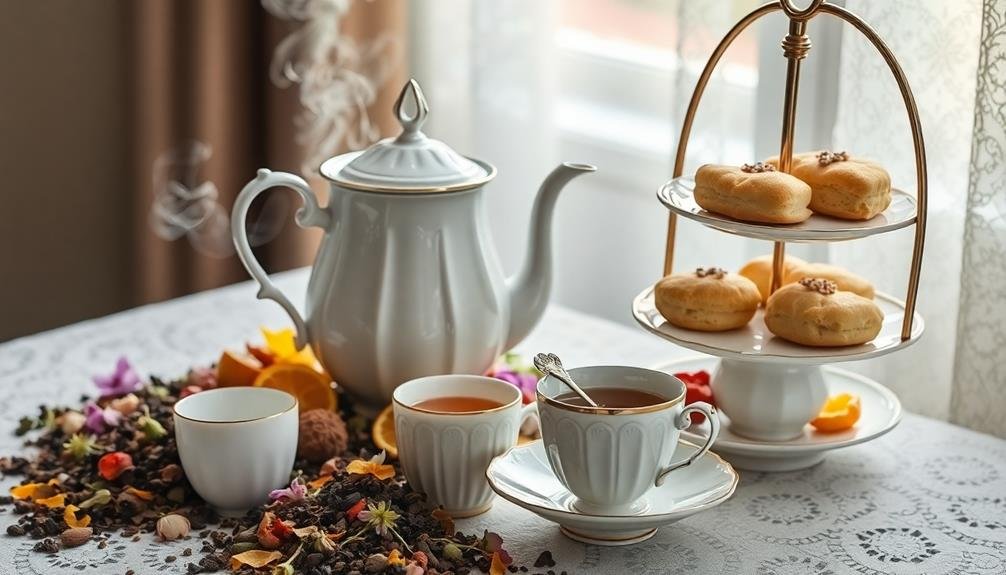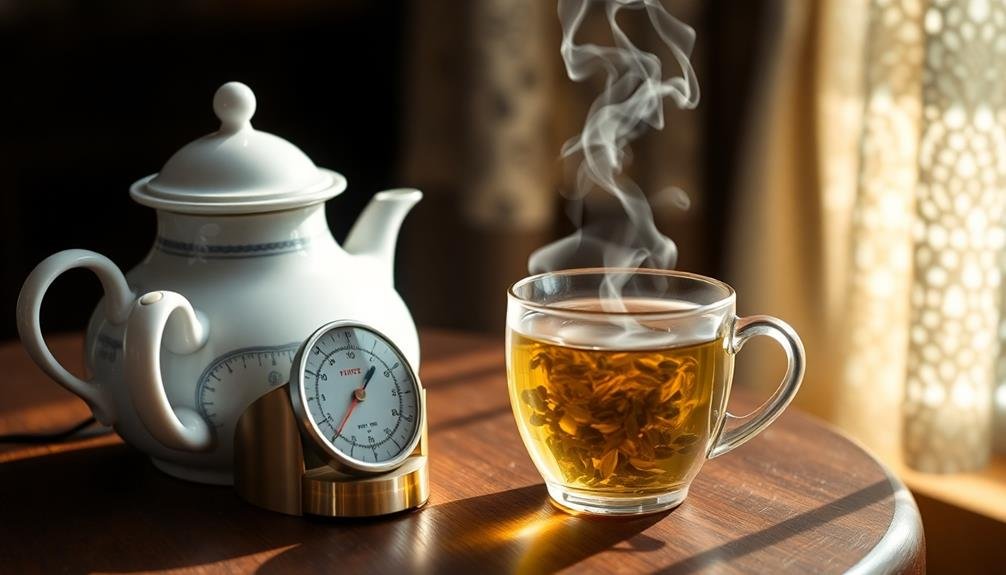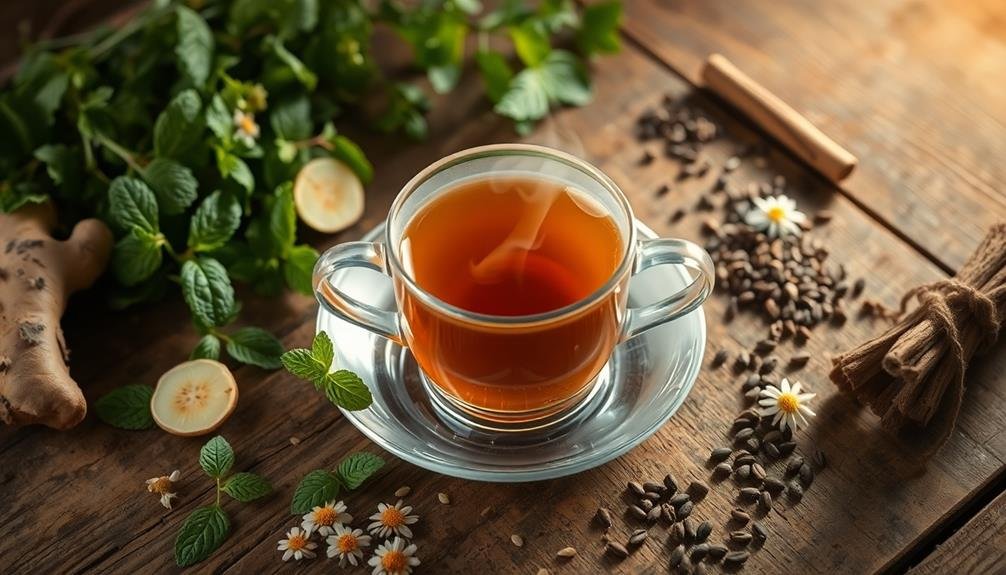To create the perfect afternoon tea blend, you'll need high-quality black tea varieties like Assam or Darjeeling as your base. Add complementary herbs and botanicals such as Earl Grey for bergamot aroma, or lighter elements like green tea and chamomile for variety. Balance flavors by considering the strength of each ingredient and layering them for depth. Choose whole, unbroken tea leaves with vibrant colors and fresh aromas. Incorporate floral elements like rose petals or spices like cinnamon for complexity. Use proper steeping techniques, including the right water temperature and steeping time for each tea type. Discover how these elements combine to create a truly exquisite afternoon tea experience.
Essential Ingredients for Afternoon Tea

Creating the perfect afternoon tea blend begins with gathering the essential ingredients.
You'll need a high-quality black tea as your base, such as Assam, Darjeeling, or Ceylon. These teas provide a robust flavor and a good caffeine kick. For added depth, consider including a small amount of Earl Grey, which offers a distinctive bergamot aroma.
To balance the strong black tea, you'll want to incorporate some lighter elements.
Green tea can add a fresh, grassy note, while white tea brings a delicate sweetness. Don't forget about herbal additions like chamomile for a soothing touch or peppermint for a revitalizing twist.
For a fruity dimension, dried berries or citrus peels work wonders.
Rose petals or lavender buds can introduce a floral aspect, enhancing both flavor and visual appeal. If you're after a spicy kick, try adding a pinch of cinnamon, cardamom, or ginger.
Balancing Flavors and Aromas
With your ingredients assembled, it's time to focus on balancing the flavors and aromas of your afternoon tea blend. You'll want to create a harmonious combination that tantalizes the taste buds and delights the senses.
Start by pondering the strength of each component and how they'll interact. A robust black tea might overpower delicate floral notes, so you'll need to adjust proportions carefully.
Next, think about the flavor profile you're aiming for. Do you want a bright, citrusy blend or a rich, malty one? Layer your ingredients to achieve depth and complexity.
Here are three key aspects to reflect on:
- Base notes: These provide the foundation and body of your blend.
- Middle notes: They add character and bridge the gap between base and top notes.
- Top notes: These offer the initial aroma and flavor that hits your senses first.
Don't forget to contemplate the mouthfeel of your blend. Some ingredients, like chamomile or mint, can add a smooth or cooling sensation.
Selecting Quality Tea Leaves

While balancing flavors is essential, the foundation of any exceptional tea blend lies in selecting high-quality tea leaves. You'll want to choose leaves that are whole, unbroken, and free from debris. Look for leaves with a vibrant color and a fresh, aromatic scent. The origin of the tea leaves also plays a significant role in their quality and flavor profile.
When selecting tea leaves, consider these key factors:
| Type | Characteristics | Best Origin |
|---|---|---|
| Black | Full-bodied, robust | Assam, Ceylon |
| Green | Light, grassy | China, Japan |
| Oolong | Complex, floral | Taiwan, Fujian |
Remember that the freshness of your tea leaves is paramount. Always check the harvest date and opt for the most recent crop. Store your tea leaves in an airtight container away from light, heat, and moisture to preserve their quality. Don't be afraid to experiment with different varieties and grades of tea leaves to find the perfect combination for your afternoon blend. By investing time in selecting quality tea leaves, you'll elevate your tea-drinking experience and create a truly memorable afternoon tea blend.
Complementary Herbs and Botanicals
To take your afternoon tea blend up a notch, you'll want to branch out into complementary herbs and botanicals. These additions can enhance the flavor profile, aroma, and health benefits of your afternoon tea. When selecting herbs and botanicals, consider their compatibility with your chosen tea base and the overall taste you're aiming for.
Popular herbs like mint, chamomile, and lavender can add invigorating or calming notes to your blend. Floral elements such as rose petals or jasmine blossoms infuse a delicate fragrance. Spices like cinnamon, ginger, or cardamom introduce warmth and depth. Citrus peels, such as lemon or orange, contribute a zesty brightness.
When incorporating herbs and botanicals, keep these tips in mind:
- Start with small amounts and adjust to taste
- Confirm your additions are food-grade and pesticide-free
- Consider the steeping time of each ingredient to avoid over-extraction
Remember that balance is key. You don't want to overpower the tea's natural flavors but rather enhance and complement them.
Experiment with different combinations to create a unique and personalized afternoon tea blend that suits your palate and mood.
Steeping Techniques for Perfect Blends

Once you've crafted your perfect afternoon tea blend, mastering the art of steeping is vital for bringing out its full potential. Start by using fresh, filtered water to guarantee a clean taste.
Heat the water to the appropriate temperature for your blend; black teas typically require boiling water (212°F), while green and white teas prefer cooler temperatures (170-185°F).
Measure your tea carefully, using about 1 teaspoon per cup for loose leaf or one tea bag for bagged tea. Place the tea in a clean infuser or teapot, and pour the hot water over it.
Steep for the recommended time, which varies by tea type: 3-5 minutes for black tea, 2-3 minutes for green tea, and 1-3 minutes for white tea.
Don't over-steep, as this can result in a bitter taste. Remove the tea leaves or bag promptly when the steeping time is up.
If you're making a large pot, consider using a tea cozy to maintain the temperature. For iced tea, brew it stronger to compensate for dilution from ice.
Experiment with these techniques to find the perfect balance for your unique afternoon tea blend.
Frequently Asked Questions
What Is the History Behind the Tradition of Afternoon Tea?
You'll find that afternoon tea originated in 1840s England. It was introduced by Anna, the Duchess of Bedford, to curb hunger between lunch and dinner. The tradition quickly spread among the upper class and remains popular today.
Are There Specific Etiquette Rules for Serving and Enjoying Afternoon Tea?
You'll find several etiquette rules for afternoon tea. Remember to use your napkin properly, hold your teacup correctly, and avoid slurping. Don't stir your tea in circles; instead, gently move the spoon back and forth.
How Does Afternoon Tea Differ From High Tea?
You'll find afternoon tea is a light, elegant affair with delicate sandwiches and pastries. It's typically served mid-afternoon. High tea, however, is a heartier meal with hot dishes, eaten later as a working-class evening supper.
What Are Some Popular Food Pairings for Afternoon Tea Blends?
You'll often find delicate finger sandwiches, scones with clotted cream and jam, and an assortment of pastries paired with afternoon tea blends. Don't forget cucumber sandwiches, petit fours, and fruit tarts for a classic experience.
Can Afternoon Tea Be Enjoyed Iced or Is It Traditionally Served Hot?
You can enjoy afternoon tea both hot and iced. While it's traditionally served hot, many tea lovers now savor invigorating iced versions, especially in warmer weather. It's all about your preference and the occasion.
In Summary
You've now got the key ingredients for creating the perfect afternoon tea blend. Remember, it's all about balance and quality. Don't be afraid to experiment with different flavors and aromas. Choose your tea leaves carefully, and consider adding complementary herbs or botanicals. Finally, master your steeping technique to bring out the best in your blend. With practice, you'll soon be crafting exquisite afternoon tea experiences that'll impress even the most discerning palates.




Leave a Reply